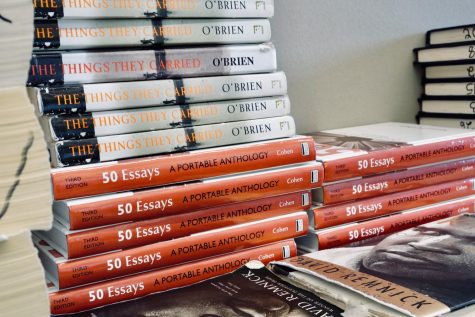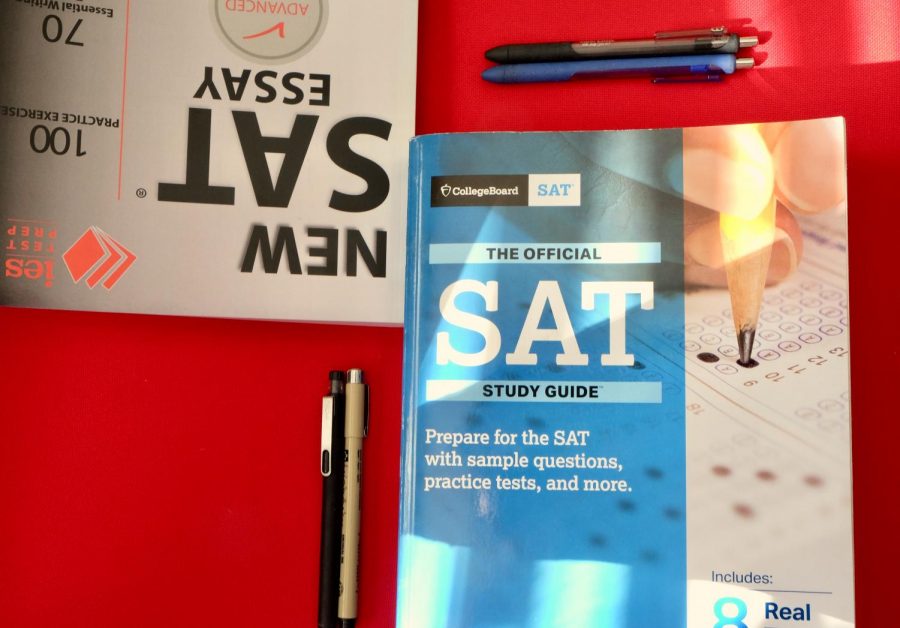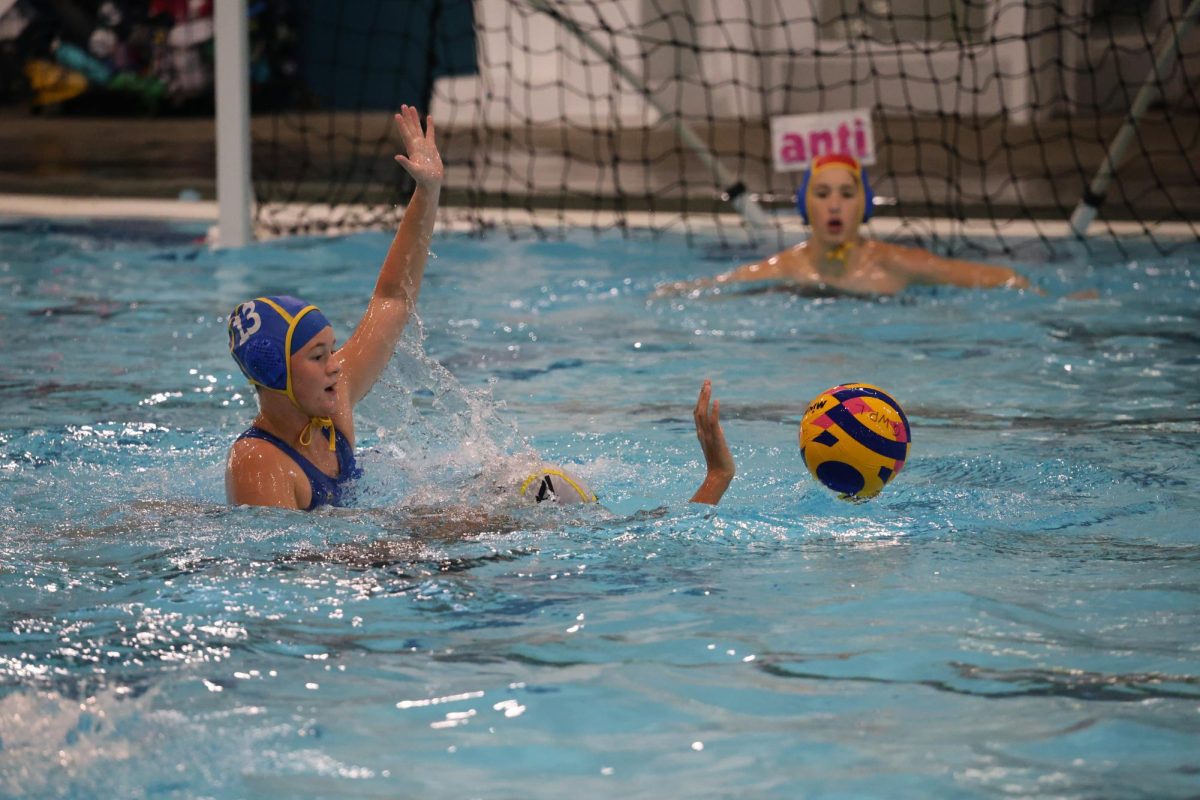English Department
Photo courtesy of Iris Tsouris.
An assortment of SAT Prep books.
January 13, 2020
SAT Prep
For those caught in the throes of College Board testing, the SAT Prep elective allows students to skip the inconvenience and cost of an independently-taught SAT Prep course and take one through the school. Similar to Chamblee’s after-school SAT Prep classes, this elective is split into two semesters of content. First semester consists of Reading/Language review taught by language arts teacher James Demer, while second semester is composed entirely of math, taught by math teacher Claudius Guynn. Although it is offered to everyone, juniors typically make up the majority of this class.
In Demer’s class, students learn grammar rules found in the SAT writing section, as well as strategies to avoid typical errors, such as misplaced modifiers and restrictive versus nonrestrictive comma usage. Demer additionally prepares review packets, drilling students on sentences that he’s constructed himself. He also teaches students how to approach the SAT essay—a tricky ordeal if one has never analyzed rhetoric before.
Students receive grades from weekly vocab quizzes, flashcards and review worksheets. Despite this, the workload is light, with minimal homework involved.
While SAT Prep encompasses content found on the actual SAT, the class is also designed to familiarize students with the test format itself. Typically, this involves taking timed practice tests from the College Board Official SAT Study Guide, which helps to build student confidence prior to test day.
“Anybody that has extra time in their schedule and wants to improve their [SAT] score will definitely succeed,” said junior Kara Dole.
And, according to students, taking SAT Prep truly does yield desirable results.
“When I took the PSAT [this year], my score went up 200 points from the original score that I had [last year],” said SAT Prep student Saray Gonzales. “A lot of the questions on the PSAT were really similar to the stuff we were doing in class.”
Writer’s Workshop
The elective for aspiring authors, Writer’s Workshop is a class where students can hone, develop and eventually perfect their writing skills. Taught by language arts teacher Jennifer Andriano, this elective—while heavy on writing—combines a peaceful, work-at-your-own-pace environment with intense creative stimulation.
The curriculum for Writer’s Workshop primarily focuses on creative writing, such as short stories. In seldom cases, it does delve into nonfiction scholarly writing, particularly persuasive essays. Students also periodically dabble in poetry, while exploring different techniques, such as writing dialogue and developing fantasy settings.
In terms of grades, students in Writer’s Workshop describe the class as an “easy A,” with a relatively light and flexible course load. That said, students typically write around one page per day. According to its participants, the class’s environment is akin to that of a peaceful coffeeshop. Students are free to listen to music while typing away at a short story or essay. Often, daily assignments are prompt-based, and on Fridays, students participate in Free-Write Fridays, where they have the option to write whatever they please. The student writers also often submit content to Chamblee’s literary magazine.
In addition to this, Andriano’s guidance of the class is widely praised.
“She’s like a mom who’s there to foster all your creativity, you know?” said Writer’s Workshop student Elliot Lucey. “She’s always there to help you. She’s just so nice; it’s such a great environment to work in.”
With Andriano’s help, students who enjoy writing, story-telling and being creative in general can expect to enjoy (and excel in) this class.
“The best part of the class has got to be all the creativity and freedom of expression that you have,” said junior Cooper Lund. “If you feel like you don’t have any classes to create in, then Writer’s Workshop is definitely something to work into [your schedule].”
AP Lang

AP Lang reading material in English teacher James Demer’s room.
The AP course that replaces American Lit for juniors, AP Language and Composition is a college-level class that focuses on rhetorical analysis, meaning the reading list does tend to gravitate towards nonfiction works. Students that choose to take this class will find themselves writing analytical essays on not what, but how authors write. At this moment, AP Lang is taught by two different teachers: James Demer and Zachary Welser. Because the two have varying teaching styles, an overview is provided of both of their classes.
Demer Lang
Demer’s version of AP Lang primarily draws reading material from 50 Essays: A Portable Anthology, which includes personal essays from Dr. Martin Luther King Jr., James Baldwin, George Orwell and more. Aside from this, he teaches various books, such as King of the World: Muhammad Ali and the Rise of an American Hero and Maus, a graphic novel about the Holocaust.
To stimulate critical thinking, Demer’s class is very discussion-oriented. These discussions, while thorough, are quite casual, making it easier for students to participate and contributing to the laid-back environment of the class. Students can get a feel for his class’s environment from Demer’s YouTube channel, where he periodically uploads highlights from his AP Lang classes.
“It’s got a very relaxed vibe. […] The best part is Mr. Demer himself, just the way that he’s so open. It’s a very conversational class, and it feels a lot less strict than a lot of core classes I’ve taken in the past,” said junior Sam Grant. “It’s not really geared towards preparing you directly for the AP exam, but it’s more focused on making you a better writer as a whole.”
A unique aspect of Demer’s class is his focus on college preparation. One assignment students receive guides them through writing their own college essay ahead of time, giving them a head start to developing their own ideas.
Although this is an AP class, it is by no means difficult to get an A in. Coupled with a very reasonable course load, Demer’s students report that he gives them ample time in class to complete assignments and essays.
Welser Lang
Welser’s AP Lang class is relatively reading-heavy, with material from Thomas Paine’s essays, George Orwell’s Nineteen Eighty-Four, translations of Aristotle and Plato’s writing and other original content from rhetorical theorists. Despite being an AP class, the workload for this class is manageable, with 45 minutes per night on average; according to his students, it is not too difficult to maintain an A.
“It’s not too much of a harsh, strict environment. It’s not the hardest class in the world,” said junior Lila David. “He does make a point to not give us homework over the weekends.”
In addition to writing essays, Welser’s students keep a reflection journal, where they analyze the reading material. Reflection journals are divided into three parts: a content summary, a reflection and a quote analysis. The reflection, in particular, gives students a creative outlet to articulate their feelings surrounding what they have just read.
Welser also gives assignments that are tailored to ensure AP exam preparation. One of his assignments includes writing a rhetorical precis, which is a four-sentence paragraph that serves as an introduction to a rhetorical analysis essay—an instrumental part of the AP Lang exam.
Moreover, students say there is never a dull moment in Welser’s class, with the student-teacher dynamic remaining stellar.
Although Demer and Welser do prepare their students for the AP exam in different ways, rising sophomores with AP Lang in mind need not let this fact deter them from taking the class.
“I’ve heard people say that Demer is more lenient, but once you get to meet Welser, I don’t think that’s really the case,” said junior Kai Neuhaus. “[Welser] may seem a little harsher, […] but once you’re in his class for a while, it’s really the same. They’re both very nice teachers.”
AP Lit
AP Literature and Composition, which replaces the British Literature credit, is another college-level English course. Instead of AP Lang’s rhetorical analysis, AP Lit focuses on literary analysis: while rhetoric focuses more on an author’s approach to communicating a subject, literary analysis handles the plot and themes of a story, meaning the reading material is more fiction-based. Taught by teachers Dr. Holly Isserstedt and Adrienne Keathley, this course is typically taken during students’ senior year.
One important aspect to note about AP Lit is that most colleges have it under the same college credit as AP Lang, meaning getting a 4 or 5 on the AP Lang exam eliminates the need to take AP Lit (and vice versa). Despite this, AP Lit’s reputation at Chamblee has some seniors coming back for more, even after passing the AP Lang exam.
“Analysis is a really useful skill, and I feel like we go through our entire high school careers without learning how to analyze anything,” said senior Sahara Hetherington. “It’s an important skill in college. […] I would have no idea how to do it if I didn’t take AP Lit.”
Hetherington, who is in Isserstedt’s class, has read books in AP Lit such as Frankenstein, Never Let Me Go, Extremely Loud & Incredibly Close, as well as some works from Edgar Allen Poe, which students have said that they enjoyed reading. In addition to assigning reading, Isserstedt runs her class by giving lectures, as well as giving monthly presentations on literature analysis.
“Dr. I is incredible. She is so brilliant […], and [her class is] really engaging,” said senior Sania Hassan. “If you haven’t had Dr. I as a teacher, then you definitely should. I think it’s the one English class at Chamblee that I’ve enjoyed.”
One difference between Isserstedt’s and Keathley’s class is the AP exam requirement: Isserstedt wants all of her students to take the AP Lit test at the end of the year, while Keathley does not have a preference in the matter. Because of this, Isserstedt’s class is more focused on preparing all students for the AP exam, while students in Keathley’s class can choose to do more creative work in lieu of AP-preparatory essays.
The two classes also have different reading material. In Keathley’s class, students read books like The Picture of Dorian Gray and The Bluest Eye.
“We have a huge focus right now on reading things from minorities,” said Keathley student Ava Lewis. “[The Bluest Eye] has really given a voice to some of the black kids in our class, like they’ve been the ones who have gotten to speak up and do projects about it.”
And as said before, Keathley’s assignments often involve an amalgamation of art and literature, giving students a creative outlet in addition to testing their analyzing skills.
Another difference from Isserstedt’s class is that some seniors consider Keathley’s class more challenging, but not excessively so.
“She’s kind of hard in that she expects a lot from you, but she’s a great teacher and a great person,” said Lewis. “The only homework we’ll ever have is reading. […] It’s just a lot of thinking through stuff.”
This is a common theme in Chamblee’s AP Lit classes. While students in both classes do say that AP Lit is reading heavy, they also maintain that the workload is not excessive, averaging around 30 minutes per night. Seniors enter AP Lit with three years of high-school English under their belt, making them well-prepared for the experience. Furthermore, both classes are discussion-oriented, with plenty of opportunities for enrichment and personal growth for students.











